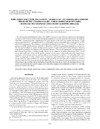Identificador persistente para citar o vincular este elemento:
https://accedacris.ulpgc.es/handle/10553/50026
| Campo DC | Valor | idioma |
|---|---|---|
| dc.contributor.author | Bouza, N. | en_US |
| dc.contributor.author | Caujapé-Castells, J. | en_US |
| dc.contributor.author | González Pérez,Miguel Ángel | en_US |
| dc.contributor.author | Batista, F. | en_US |
| dc.contributor.author | Sosa, Pedro A. | en_US |
| dc.contributor.other | Caujape-Castells, Juli | - |
| dc.contributor.other | Sosa, Pedro A. | - |
| dc.date.accessioned | 2018-11-24T12:39:40Z | - |
| dc.date.available | 2018-11-24T12:39:40Z | - |
| dc.date.issued | 2002 | en_US |
| dc.identifier.issn | 1058-5893 | en_US |
| dc.identifier.uri | https://accedacris.ulpgc.es/handle/10553/50026 | - |
| dc.description.abstract | We used random amplified polymorphic DNA (RAPD) markers to assess the levels and structuring of genetic variation in the Canarian laurel forest endangered endemics Dorycnium spectabile (Fabaceae) and Isoplexis chalcantha (Scrophulariaceae). Amplification of seven primers in the only two extant populations of each species resulted in 28 (D. spectabile) and 32 (I. chalcantha) markers that exhibited a polymorphism of 78% and 100%, respectively. The estimates of population subdivision show that ca. 75% and 25% of the total genetic variability of both species is explained by the within‐ and between‐population components, respectively. Our favored hypothesis to explain the high levels of genetic variation detected in both endemics is that they originated from multiple introductions of continental ancestors. The recent fragmentation and degradation of the Canarian laurel forest probably brought about a severe reduction of interpopulation gene flow in both species that might have disrupted the genetic cohesion of once more widespread geographic ranges. Intrapopulation spatial autocorrelation analyses indicate that the genetic variability of D. spectabile and I. chalcantha is structured in family clumps whose maintenance and enhancement is best explained by assortive mating and short‐range seed dispersal capabilities. Because of the extreme vulnerability of these two endemics and their high levels of interpopulation genetic differentiation, we recommend protecting all their natural areas of occurrence and avoiding mixing individuals from different populations. Patch size estimates derived from spatial autocorrelation were used to suggest seed collection strategies that minimize the probability of sampling genetically similar individuals. | en_US |
| dc.language | eng | en_US |
| dc.publisher | 1058-5893 | |
| dc.relation.ispartof | International Journal of Plant Sciences | en_US |
| dc.source | International Journal of Plant Sciences [ISSN 1058-5893], v. 163, p. 619-630 | en_US |
| dc.subject | 240903 Genética de poblaciones | en_US |
| dc.subject | 241714 Genética vegetal | en_US |
| dc.subject.other | Canary Islands | en_US |
| dc.subject.other | Conservation genetics | en_US |
| dc.subject.other | Endangered species | en_US |
| dc.subject.other | Gene flow | en_US |
| dc.subject.other | Genetic variation | en_US |
| dc.subject.other | RAPDs | en_US |
| dc.title | Population structure and genetic diversity of two endangered endemic species of the Canarian laurel forest: Dorycnium spectabile (Fabaceae) and Isoplexis chalcantha (Scrophulariaceae) | en_US |
| dc.type | info:eu-repo/semantics/Article | en_US |
| dc.type | Article | en_US |
| dc.identifier.doi | 10.1086/339720 | |
| dc.identifier.scopus | 0036289893 | - |
| dc.identifier.isi | 000176098700014 | - |
| dcterms.isPartOf | International Journal Of Plant Sciences | |
| dcterms.source | International Journal Of Plant Sciences[ISSN 1058-5893],v. 163 (4), p. 619-630 | |
| dc.contributor.authorscopusid | 6506749306 | - |
| dc.contributor.authorscopusid | 6603829497 | - |
| dc.contributor.authorscopusid | 6701779932 | - |
| dc.contributor.authorscopusid | 7003808680 | - |
| dc.contributor.authorscopusid | 6701688995 | - |
| dc.description.lastpage | 630 | - |
| dc.description.firstpage | 619 | - |
| dc.relation.volume | 163 | - |
| dc.investigacion | Ciencias | en_US |
| dc.type2 | Artículo | en_US |
| dc.contributor.daisngid | 5839640 | - |
| dc.contributor.daisngid | 758233 | - |
| dc.contributor.daisngid | 1956718 | - |
| dc.contributor.daisngid | 32236661 | |
| dc.contributor.daisngid | 4280387 | - |
| dc.contributor.daisngid | 935154 | - |
| dc.identifier.investigatorRID | J-8938-2015 | - |
| dc.identifier.investigatorRID | L-1861-2014 | - |
| dc.utils.revision | Sí | en_US |
| dc.contributor.wosstandard | WOS:Bouza, N | |
| dc.contributor.wosstandard | WOS:Caujape-Castells, J | |
| dc.contributor.wosstandard | WOS:Gonzalez-Perez, MA | |
| dc.contributor.wosstandard | WOS:Batista, F | |
| dc.contributor.wosstandard | WOS:Sosa, PA | |
| dc.date.coverdate | Enero 2002 | |
| dc.identifier.ulpgc | Sí | es |
| dc.description.scie | SCIE | |
| item.grantfulltext | open | - |
| item.fulltext | Con texto completo | - |
| crisitem.author.dept | GIR IUNAT: Biología Integrativa y Recursos Biológicos | - |
| crisitem.author.dept | IU de Estudios Ambientales y Recursos Naturales | - |
| crisitem.author.dept | Departamento de Biología | - |
| crisitem.author.orcid | 0000-0002-8619-3004 | - |
| crisitem.author.parentorg | IU de Estudios Ambientales y Recursos Naturales | - |
| crisitem.author.fullName | González Pérez,Miguel Ángel | - |
| crisitem.author.fullName | Sosa Henríquez, Pedro Antonio | - |
| Colección: | Artículos | |
Citas SCOPUSTM
29
actualizado el 08-jun-2025
Citas de WEB OF SCIENCETM
Citations
29
actualizado el 08-jun-2025
Visitas
84
actualizado el 21-oct-2023
Descargas
169
actualizado el 21-oct-2023
Google ScholarTM
Verifica
Altmetric
Comparte
Exporta metadatos
Los elementos en ULPGC accedaCRIS están protegidos por derechos de autor con todos los derechos reservados, a menos que se indique lo contrario.
